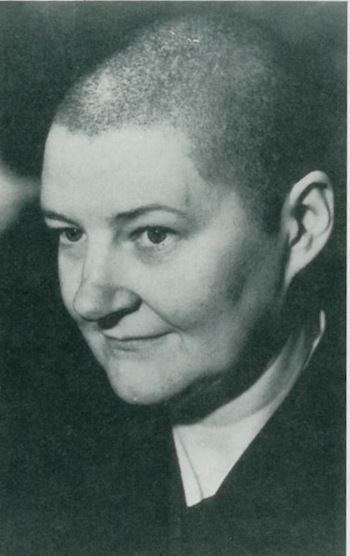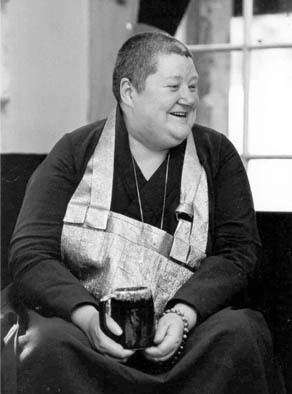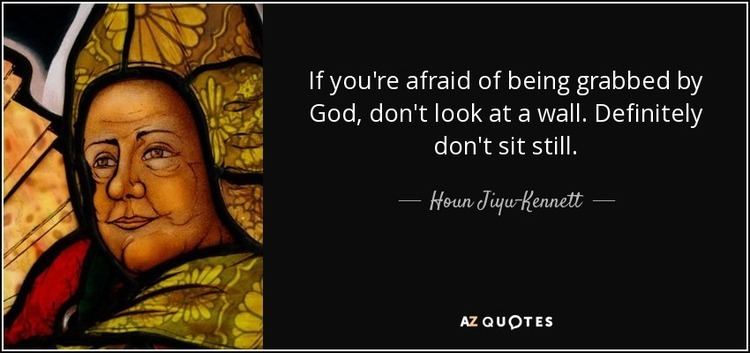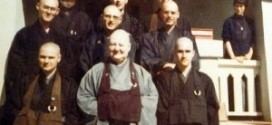Titles Roshi | Name Houn Jiyu-Kennett Predecessor Keido Chisan Koho | |
 | ||
Successor Daizui MacPhillamyformer Head of the OrderHaryo YoungHead of the OrderEko LittleFormer Abbot of Shasta AbbeyMeian ElbertCurrent Abbess of Shasta AbbeyDaishin MorganAbbot of Throssel Hole AbbeyGyokuko CarlsonKyogen CarlsonJames Ishmael Ford Teacher Seck Kim SengSuigan Yogo Books Zen is eternal life, The wild - white goose, Roar of the Tigress: The Oral, Serene reflection meditation, How to Grow a Lotus Blo | ||
Houn Jiyu-Kennett (Japanese: 法雲慈友ケネット, January 1, 1924 – November 6, 1996), born Peggy Teresa Nancy Kennett, was a British roshi most famous for having been the first female to be sanctioned by the Soto School of Japan to teach in the West.
Contents
- Early years
- Start of Buddhist studies
- Dharma transmission
- Abbess and start of teaching career
- Resignation as abbess
- Visions
- Teaching style
- Dharma heirs
- Legacy
- References

Early years

Houn Jiyu-Kennett was born as Peggy Teresa Nancy Kennett in St. Leonards-on-Sea, Sussex, England on January 1, 1924. As a young woman she found herself questioning gender roles in society and grew to become disillusioned with Christianity. She studied medieval music at Durham University and then received a scholarship to Trinity College of Music in London, England. Though attracted to Buddhism, she felt during this period that she was called to serve the Church of England as a priest. However, church policies at the time did not allow women to be ordained, and this enhanced her previous disillusionment with Christianity.
Start of Buddhist studies

She first became interested in Theravada Buddhism during this period of questioning and searching, joining the London Buddhist Vihara. In 1954 she joined the London Buddhist Society, where she continued her Buddhist studies and lectured. While there, she met the scholar D.T. Suzuki, and developed a strong interest in Zen Buddhism. In 1960 when Keido Chisan Koho of Sojiji in Japan came to the society, she was asked to make the arrangements for his stay. Koho asked if she would consider becoming his student back in Japan. She accepted the offer, and two years passed before she arrived at Sojiji to study under him.

In January 1962, Kennett traveled to Malaysia to accept an award she had been honored with for setting a Buddhist hymn, "Welcome Joyous Wesak Day" by Sumangalo, to music. Before leaving for Japan, Kennett was ordained a śrāmaṇerī (novice nun) by Venerable Seck Kim Seng (釋金星; Shì Jīnxīng) in the Linji Chan school and given the Buddhist name Jiyu (慈友, Cíyou in Chinese, Jiyu in Japanese) meaning compassionate friend.

Jiyu-Kennett arrived in Japan in 1962. She trained at Sojiji under Keido Chisan Koho Zenji—from whom she received Dharma transmission in 1963. Because Koho was often preoccupied with administrative affairs, Jiyu-Kennett spent much of her time studying under one of Koho Zenji's senior officers, Suigan Yogo roshi. She remained until after the death of her master Koho in 1967.
Dharma transmission
According to James Ishmael Ford,
Jiyu Kennett Roshi received Dharma transmission twice, from both Suigan Yogo Roshi and Chisan Koho Roshi.
Jiyu-Kennett's Zuise ceremony was conducted in public in Japan. Previously women's ceremonies were held in private. Koho had decided that the practice of holding private ceremonies for women and public ceremonies for men was wrong. According to Jiyu-Kennett's account,
I have never done a ceremony with more terror inside me than that one with twelve men down each side, each one with curtains drawn as if to say 'I'm not here.' Those were the witnesses. Try that sometime! That can be pretty scary—in a foreign country, in a language you're not one hundred percent sure of, with a lot of people who are hating your guts. And the reason Koho Zenji did it—and I've got it on tape—was for the benefit of women in his country.
Abbess and start of teaching career
Following her graduation ceremony, Jiyu-Kennett was installed as abbess of Unpukuji temple in Mie prefecture. By 1969 she received authorization to begin teaching Sōtō Zen in London, England. That year, she visited the United States on a lecture tour and decided to remain. At this time Jiyu-Kennett was not in good health, as during her time in Japan she had experienced many illnesses. In 1969 Jiyu-Kennett founded the Zen Mission Society in San Francisco, and in 1970 Shasta Abbey in Mount Shasta, California, the first Soto Zen school in the United States to be established by a woman. In 1972, Jiyu-Kennett's British chapter of the Zen Mission Society established Throssel Hole Priory in Northumberland, England. In 1978 Jiyu-Kennett changed the name of the Zen Mission Society to the Order of Buddhist Contemplatives.
Resignation as abbess
In 1975 Jiyu-Kennett was stricken with illness yet again, and this time she became bedridden. In 1976 she resigned from her position as abbess of Shasta Abbey and went into retreat in Oakland, California. Still rather ill, of unknown causes, she had her student Daizui MacPhillamy with her often to tend to her care. Following a kensho experience he had, she conferred Dharma transmission to him at her bedside in 1976.
Visions
Not long after she began having visions. Stephen Batchelor describes these episodes,
The visions lasted for 12 months, until 26 January 1977, the first twelve occurring in Oakland, the rest at Shasta, where she returned on 25 October. Each vision unfolded as a dream-like episode, charged with Western and Buddhist religious symbolism, superimposing itself on whatever she saw around her. She compared the series of visions to an elaborated contemporary version of the classical Zen images of the ten 'ox-herding' pictures. By the time the final vision faded, she was cured. She interpreted the experience as that of a 'third kensho.'"
Teaching style
Jiyu-Kennett had a commanding presence about her, both intellectually as well as physically. Of a rather husky build, she had a tremendous laughter and was known to be gifted at storytelling. To some, her demeanor appeared rather persistent at times, as author James Ishmael Ford writes,
My memories of Jiyu Kennett Roshi as a teacher are mixed. She followed in the authoritarian style of her Japanese inheritance. Interpersonally, she was remarkably invasive. Indeed, in my twenties, she pushed me into a marriage with another student that would cause great unhappiness for both of us. On the other hand, she had genuine insight into the boundless realm and also pushed me toward my own deepest experience of the great matter."
According to the book The Encyclopedia of Women and Religion in North America,
Her adaptation of Zen for Westerners has been likened to Japanese Soto Zen with a flavor of the Church of England, for she believed that Zen in North America should adopt Western monastic dress and liturgical forms. For example, she set the traditional Buddhist liturgy to music based on Gregorian chants."
Jiyu-Kennett was an advocate for equality between the sexes, and was herself swayed by the idea that women would never be deemed as equal to men if they were not understood to possess souls. According to author Catherine Lowman,
She asserts that no woman will be certain she is equal 'until she knows with the certainty that I know, that her own Buddha-nature, or her own soul, exists.'"
Dharma heirs
In 1985 new rules had been implemented within the Order of Buddhist Contemplatives that required monastics to be celibate, and Gyokuko Carlson and Kyogen Carlson chose to part ways with the community rather than seek a divorce. As a consequence, their center in Portland, Oregon (today's Dharma Rain Zen Center) chose to break ties with Shasta Abbey, and ultimately invited the Carlsons to remain their leaders, a position they would share until Kyogen's death in 2014.
Legacy
The Order of Buddhist Contemplatives, founded by Jiyu-Kennett, now has chapters in the United States, the Netherlands, Canada, the West Indies, the United Kingdom and Germany.
